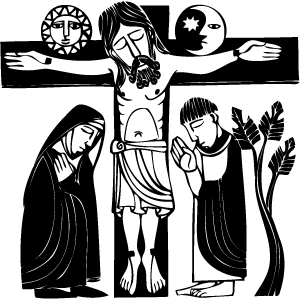Originally written in 2013 but never published.
I got an email from a guy named Bob recently. We went back and forth a bit over a couple of days, but basically he was asking if I thought God sent Jesus into this world specifically to die for our sins. Or did Jesus come to humanity in order to teach and preach and show us how to live? But then we humans, being the sort of creatures to royally screw up almost every good thing we have, got mad at him and decided to nail him to a cross outside of Jerusalem.
This is what I told him:
Hey Bob,
If I had to guess, I’d say that you’ve come across the Judas paradox. If the death of Jesus was God’s plan to save humanity, why are the gospel writers and Christians so angry with Judas? Perhaps we should have made a saint out of him.
What you are asking is – at least in part – a soteriological question. That’s the fancy seminary word for discussions about what exactly Jesus did for us when he died on the cross. If you go to the wikipedia article on Christian Salvation, you can read summaries of how Christian people have thought about the death of Christ over the years.
I don’t particularly care for soteriology. It depresses the hell out of me, to tell you the truth. I don’t like reading about how Christians have torn the death of Jesus to pieces over the years by dissecting it, creating theories about it, and then fighting over whose sophomoric paradigm is the most accurate. An image that comes to my mind is of a bunch of children drawing pictures of their father with crayons and then arguing over which one should be displayed on the refrigerator.
It almost feels to me like we crucify Jesus all over again by doing that.
But if I do think about soteriology, I think people fall into three basic groups in their approaches to understanding the story of Jesus.
1. Literal understandings of his death and resurrection.
For many people, the story of Jesus as told by the Church is a historical narrative in the modern tradition of newspaper reporting. It happened more or less as you read it in the gospels. The basic story is clear. Jesus is God. Jesus came to humanity to pay a price with his death that if not paid would mean the ultimate doom of humankind.
I always try to remember that this has been the majority view of the Christian community throughout history. The people of this viewpoint live fully immersed in the narrative of the life and death of Jesus. And this view communicates the deepest truths of Christianity in a beautiful and almost effortless way across a broad spectrum of humanity. It doesn’t matter whether you are educated or not, sophisticated or not, smart or not. The deep truths get transmitted. God loves us. We have not always been good people. We have violated our own ideas of goodness, much less God’s ideas of how we should live. Evil is like a disease. It spreads and grows. Setting it right is cosmically expensive. It took the death of the Son of God to set things right.
There you go. Message received. Truth digested. Lives made better as people try to live graciously into their receiving of this gift of God.
2. Non-literal Viewpoints.
There are Christians who struggle to believe that Jesus died and then came back to life. Because, well, that’s crazy talk. If anyone said someone died and came back to life in any other context, even literal believing Christians would call that person crazy. Some people just can’t bring themselves to believe something like this really happened.
However, many of these people feel their own brokenness and have a desire to be “connected with God,” whatever that means to them. And they have found that the Christian story along with its worshipful observances and rituals are transformative for their lives. So they hold their doubts in their minds – often secretly and with shame, which makes me very sad – and participate in our faith tradition with their bodies and their best intentions. They say, “I want to believe in God. I love church and prayer and my faith community. I do the best I can to be faithful.”
These people illustrate real faith, which is faithfulness. They are like Saint Thomas, who doubted but did not leave his community of friends, even though he did not believe their accounts of the resurrection. I’ve noticed and experienced myself, that these dear saints – like Thomas – generally get what they need from God eventually.
3. Archetypal Viewpoints.
Some thinkers see deep, cosmic truths present in human faith traditions and their archetypal stories. They wonder if the rich narratives of human religions might be the best and most beautiful way a loving, higher mind would communicate to simple, human creatures of all intelligences and abilities.
These people see religious traditions as great works of human art, far beyond the ability of any single artist to create. The stories, music, rituals, and worship evolve slowly over thousands of years. There is even a kind of natural selection at work, as the preferences of the followers smooth the rough edges of the stories and their theology over millennia to match the growing ethical maturity of the community. Those of simple and pure faith who live fully in these traditions as true believers are seen as incredibly valuable assets to our species, because the organic growth of such a tradition can only occur when people truly believe.
For those who see our Christian faith as one of several major spiritual traditions in an archetypal view, detailed questions about paradoxes pulled from the narratives are rather meaningless. They realize that the long, broad, stories of faith traditions are filled with ambiguous artifacts from earlier forms. They value these paradoxes as witnesses to our growth and limited understanding of truth, much the way an archaeologist can value a simple pot from an earlier human time.
What about me?
So where am I in this spectrum, you might ask. Well, the simple 1,2,3 above is a good picture of my own journey. I am the son of true believers, raised solidly in a believing community. For much of my early life, the Christian story was my only story. But I have a naturally skeptical mind. And so for many years I struggled, wanting to remain with my faith family but unable to believe so many things others seemed to believe easily. I was both ashamed and proud. Neither of those reflects a very mature viewpoint.
It wasn’t until mid-life that I embraced other religious traditions in peace and with love. I feel at home with an archetypal appreciation for my faith and the faith of others.
And I wonder if you noticed, as I have noticed, that #1 and #3 are in fact very close. One can almost go full circle here, ending up at the beginning. The true believers who brought me up in this world are, in fact, the prime movers and creators of Christianity. And I love them dearly. They are both pure in heart and poor in spirit. Therefore Jesus has said that they shall see God and inherit the Kingdom of Heaven. (Matthew 5:3-4??)
I seek always now in my prayers a simplicity of heart and mind. My current faith statement is, therefore, simple and cosmic:
I’m a sinner. Christ died for me. Christ is in me helping me to be a loving instrument of peace in my world.
That is all I say. It is not much. And it is enough.
Gordon Atkinson


